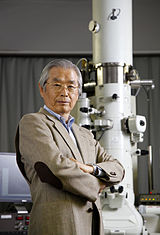Sumio Iijima | |
|---|---|
 Iijima at Meijo University | |
| Born | 2 May 1939 Koshigaya, Saitama, Japan |
| Alma mater | Tohoku University University of Electro-Communications |
| Known for | High resolution electron microscope and Carbon nanotubes |
| Awards | See below |
| Scientific career | |
| Fields | Nanotechnology |
| Institutions |
|
Sumio Iijima (飯島 澄男, Iijima Sumio, born 2 May 1939) is a Japanese physicist and inventor, often cited as the inventor of carbon nanotubes. Although carbon nanotubes had been observed prior to his "invention", Iijima's 1991 paper generated unprecedented interest in the carbon nanostructures and has since fueled intense research in the area of nanotechnology.
Born in Saitama Prefecture in 1939, Iijima graduated with a Bachelor of Engineering degree in 1963 from the University of Electro-Communications, Tokyo. He received a Master's degree in 1965 and completed his Ph.D. in solid-state physics in 1968, both at Tohoku University in Sendai.
Between 1970 and 1982 he performed research with crystalline materials and high-resolution electron microscopy at Arizona State University. He visited the University of Cambridge during 1979 to perform studies on carbon materials.
He worked for the Research Development Corporation of Japan from 1982 to 1987, studying ultra-fine particles, after which he joined NEC Corporation where he is still employed. He discovered carbon nanotubes in 1991. When he discovered carbon nanotubes, he not only took pictures of them but he put two together and explained what they really are. Afterwards, he was credited with the discovery.[1] He is also a University Professor at Meijo University since 1999. Furthermore, he is the Honorary AIST Fellow of the National Institute of Advanced Industrial Science and Technology, Distinguished Invited University Professor of Nagoya University.
He was awarded the Benjamin Franklin Medal in Physics in 2002, "for the discovery and elucidation of the atomic structure and helical character of multi-wall and single-wall carbon nanotubes, which have had an enormous impact on the rapidly growing condensed matter and materials science field of nanoscale science and electronics."
He is a foreign associate of National Academy of Sciences, foreign member of the Norwegian Academy of Science and Letters.[2] He is also a Member of the Japan Academy.
- ^ Iijima, Sumio (1991), "Helical microtubules of graphitic carbon", Nature, 354 (6348): 56–58, Bibcode:1991Natur.354...56I, doi:10.1038/354056a0, S2CID 4302490
- ^ "Gruppe 2: Fysikkfag (herunder astronomi, fysikk og geofysikk)" (in Norwegian). Norwegian Academy of Science and Letters. Retrieved 7 October 2010.